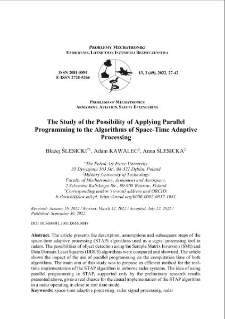Nasza Biblioteka Cyfrowa udostępnia 1 868 obiektów cyfrowych
Obiekt
Tytuł: The Study of the Possibility of Applying Parallel Programming to the Algorithms of Space-Time AdaptiveProcessing ; The Study of the Possibility of Applying Parallel Programming to the Algorithms of Space-Time AdaptiveProcessing
Tytuł odmienny:
Badanie możliwości zastosowania programowania równoległego do algorytmów adaptacyjnego przetwarzania przestrzenno-czasowego ; Badanie możliwości zastosowania programowania równoległego do algorytmów adaptacyjnego przetwarzania przestrzenno-czasowego
Współtwórca:
Adam KAWALEC, Anna ŚLESICKA ; Adam KAWALEC, Anna ŚLESICKA
Abstrakt:
The article presents the description, assumptions and subsequent steps of the space-time adaptive processing (STAP) algorithms used as a signal processing tool in radars. The possibilities of object detection using the Sample Matrix Inversion (SMI) and Data Domain Least Squares (DDLS) algorithms were compared and showned. The article shows the impact of the use of parallel programming on the computation time of both algorithms. The main aim of this study was to propose an efficient method for the realtime implementation of the STAP algorithm in airborne radar systems. The idea of using parallel programming in STAP, supported only by the preliminary research results presented above, gives a real chance for the casual implementation of the STAP algorithm in a radar operating in close to real time mode.
;
The article presents the description, assumptions and subsequent steps of the space-time adaptive processing (STAP) algorithms used as a signal processing tool in radars. The possibilities of object detection using the Sample Matrix Inversion (SMI) and Data Domain Least Squares (DDLS) algorithms were compared and showned. The article shows the impact of the use of parallel programming on the computation time of both algorithms. The main aim of this study was to propose an efficient method for the realtime implementation of the STAP algorithm in airborne radar systems. The idea of using parallel programming in STAP, supported only by the preliminary research results presented above, gives a real chance for the casual implementation of the STAP algorithm in a radar operating in close to real time mode.
Miejsce wydania:
Warszawa
;
Warszawa
Wydawca:
Wojskowa Akademia Techniczna ; Wojskowa Akademia Techniczna
Data utworzenia:
Data złożenia:
Data akceptacji:
Data wydania:
Rozmiar:
Identyfikator:
oai:ribes-88.man.poznan.pl:2645
Sygnatura:
DOI 10.5604/01.3001.0016.0048 ; DOI 10.5604/01.3001.0016.0048
ISSN elektroniczny:
ISSN drukowany:
Język:
Licencja:
kliknij tutaj, żeby przejść ; kliknij tutaj, żeby przejść
Właściciel praw:
Wojskowa Akademia Techniczna ; Wojskowa Akademia Techniczna
Strona początkowa:
Strona końcowa:
Tom:
Słowa kluczowe:
space-time adaptive processing, radar signal processing, radar ; space-time adaptive processing, radar signal processing, radar
Kolekcje, do których przypisany jest obiekt:
Data ostatniej modyfikacji:
13 paź 2025
Data dodania obiektu:
13 paź 2025
Liczba wyświetleń treści obiektu:
0
Wszystkie dostępne wersje tego obiektu:
https://ribes-88.man.poznan.pl/publication/2974
Wyświetl opis w formacie RDF:
Wyświetl opis w formacie OAI-PMH:
| Nazwa wydania | Data |
|---|---|
| The Study of the Possibility of Applying Parallel Programming to the Algorithms of Space-Time AdaptiveProcessing | 13 paź 2025 |

